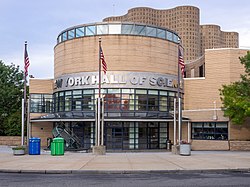
Back New York Hall of Science Catalan Novjorka Halo de Scienco Esperanto New York Hall of Science Spanish New York Hall of Science Finnish New York Hall of Science French New York Hall of Science Italian Нью-Йоркский зал науки Russian New York Hall of Science SIMPLE New York Hall of Science Swedish 纽约科学馆 Chinese
 | |
 Entrance with the original building in the background (2019) | |
 | |
| Established | 1964 |
|---|---|
| Location | 47-01 111th Street Corona, New York |
| Coordinates | 40°44′50″N 73°51′06″W / 40.7472°N 73.8517°W |
| Type | Science-technology museum |
| Accreditation | ASTC |
| Public transit access | Subway: Bus: Q23, Q58 at 108th Street, Q48 at Roosevelt Avenue[1] |
| Nearest car park | On-site |
| Website | nysci |
The New York Hall of Science, branded as NYSCI, is a science museum at 47-01 111th Street, within Flushing Meadows–Corona Park, in the Corona neighborhood of Queens in New York City, New York. It occupies one of the few remaining structures from the 1964 New York World's Fair, along with two annexes completed in 1996 and 2004. There are more than 400 interactive exhibits, which focus on biology, chemistry, and physics. Wallace Harrison designed the original structure, a 80-foot-high (24 m) curving concrete structure called the Great Hall. It adjoins an entrance rotunda designed by Beyer Blinder Belle; a glass-and-metal north wing designed by Todd H. Schliemann; a science playground; and Rocket Park, which contains a collection of spacecraft.
The museum includes the Hall of Science pavilion and the adjacent Space Park, developed for the 1964 New York World's Fair. The Hall of Science opened as a fair attraction on June 16 and reopened as a museum on September 21, 1966. There was an attempt to renovate the museum in the 1970s. The museum was temporarily shuttered in January 1981 for another renovation, but, due to financial issues, it was abandoned after the renovation was completed in 1983. Alan J. Friedman took over, reopening it in 1986; he also oversaw the development of the two annexes. The original building was renovated between 2009 and 2015. It was temporarily closed during the early 2020s due to the COVID-19 pandemic and Hurricane Ida.
The New York Hall of Science mainly focuses on children's education. It includes a large permanent collection and range of traveling exhibitions. It has hosted numerous temporary exhibits over the years, although many of its exhibits in the 1960s and 1970s had only a tangential connection to science. It offers several programs for students, operates the Alan J. Friedman Center for youth education and holds events such as the seasonal Queens Night Market and Maker Faire.
- ^ "Queens Bus Map" (PDF). Metropolitan Transportation Authority. August 2022. Retrieved September 29, 2022.